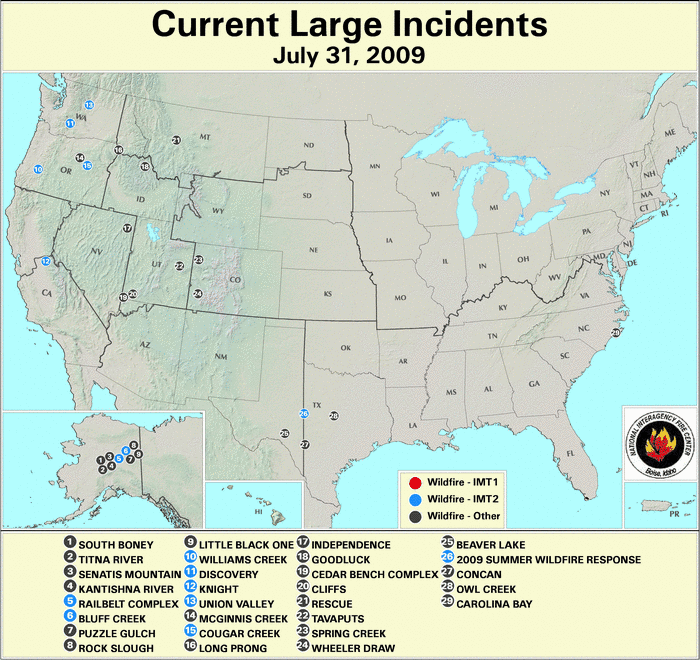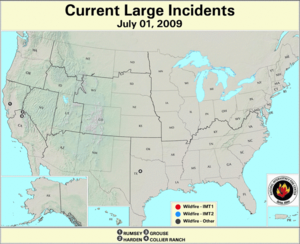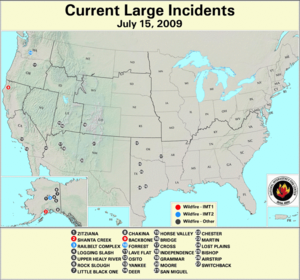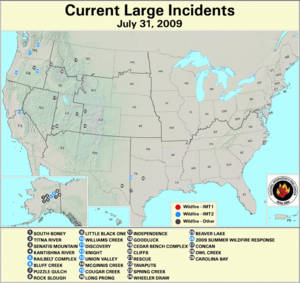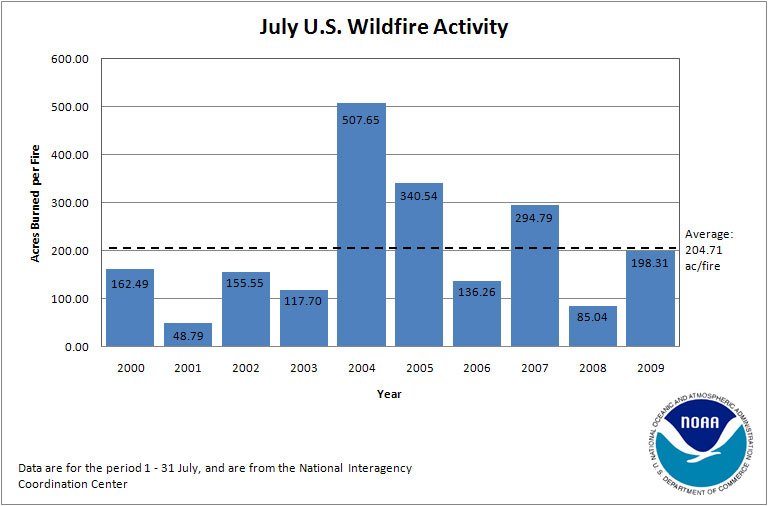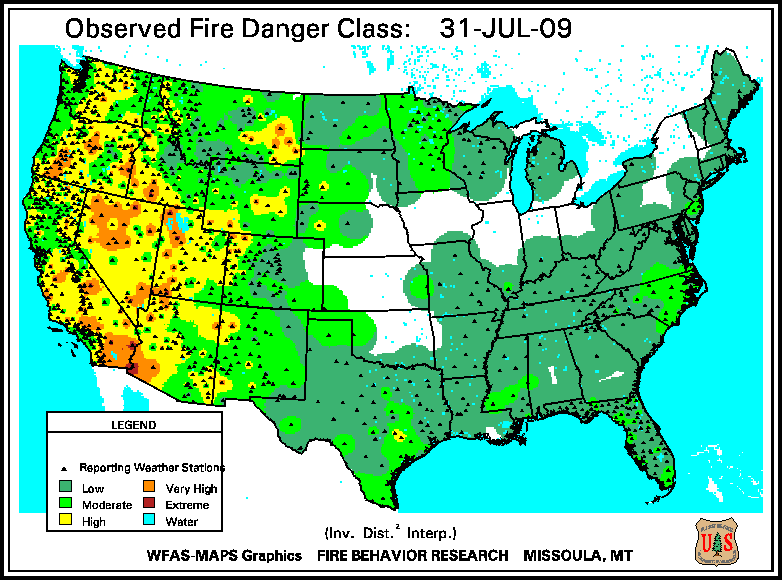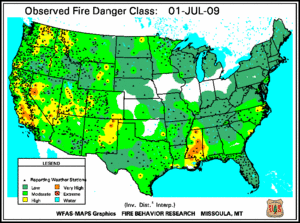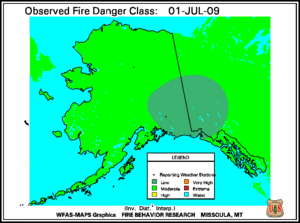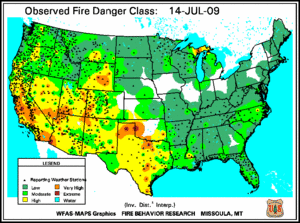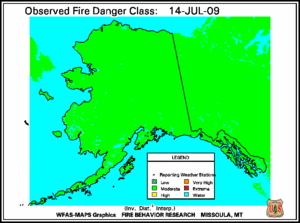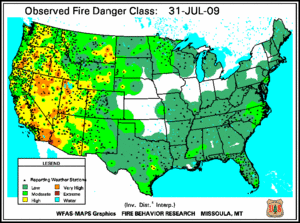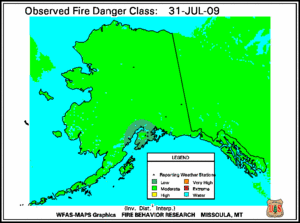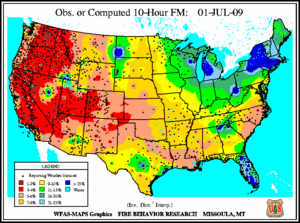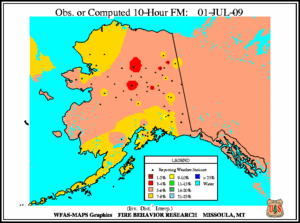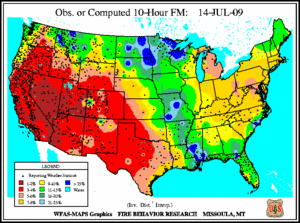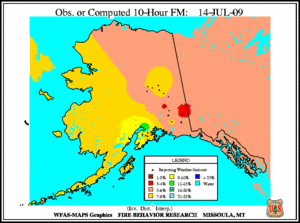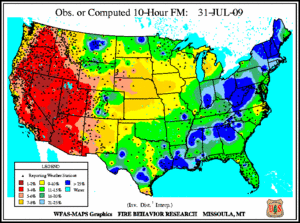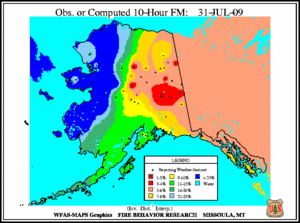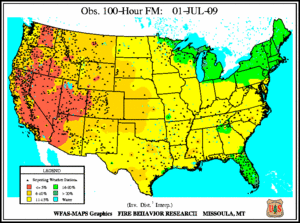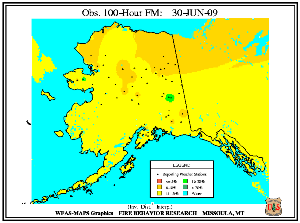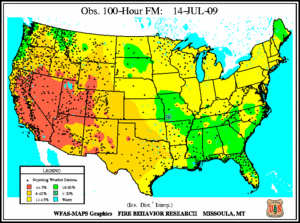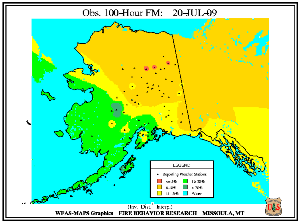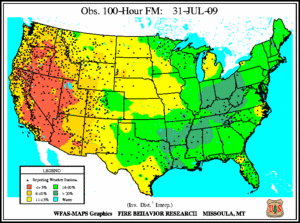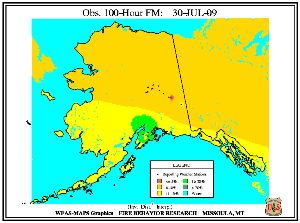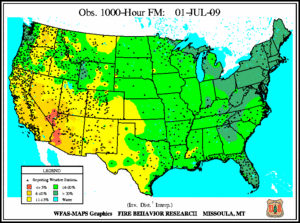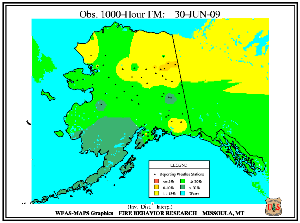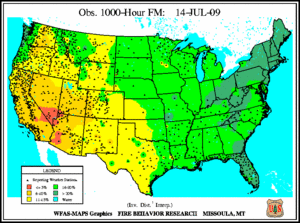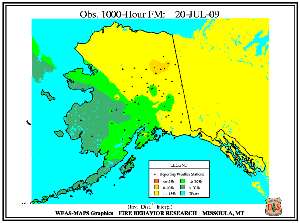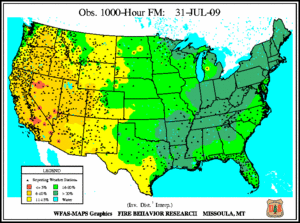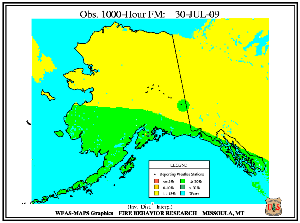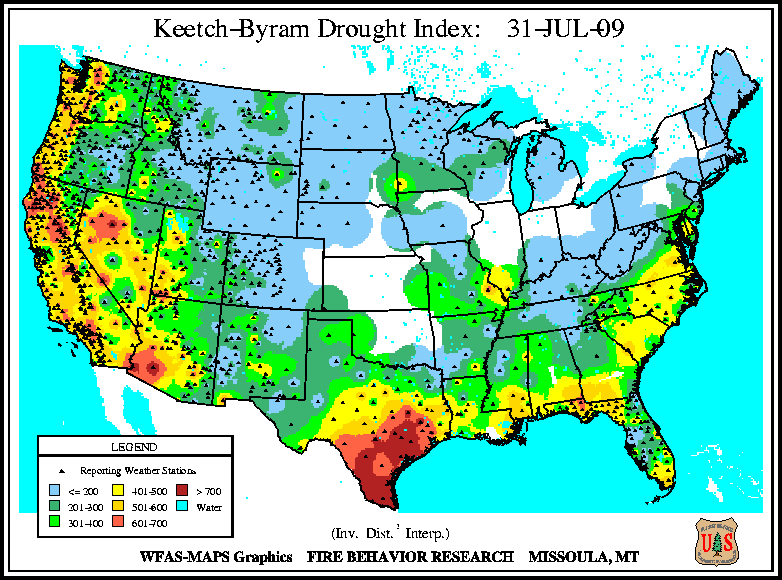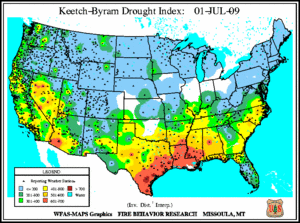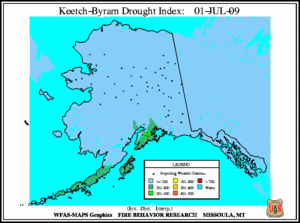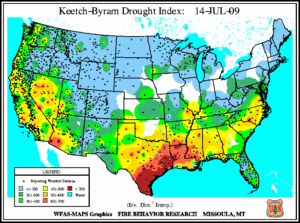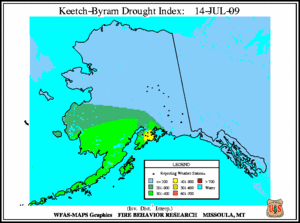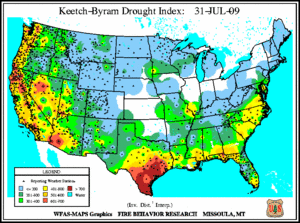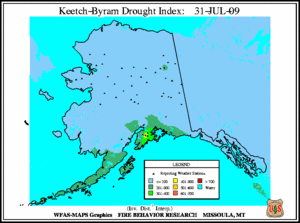Updated: 7 August 2009
The relatively low wildfire activity of just four large fires (three in California and one in Texas) at the end of June was not to continue into July. By July 7th, fourteen large fires were active, including four in Alaska. By the middle of the month, that number had nearly doubled to 27 active large fires (eight in Alaska, four each in California and Texas, three in Arizona, two each in Utah, New Mexico and Oklahoma, and one each in Washington, Oregon and Colorado). According to the National Interagency Fire Center, large wildfire activity reached an apex on July 16th when 33 large fires were burning in Alaska and an area from Oregon southeast across to the Texas–Louisiana border. While fire activity decreased modestly for two weeks thereafter, the number of fires rebounded in the last two days of the month, and July closed with 29 active large fires in 11 states, including eight in Alaska, and one in coastal North Carolina. For the month, the majority of wildfire activity was concentrated in Alaska and in a region from Oregon southeastward to eastern Texas. Only six large fires occurred east of the Mississippi River during July.
2009 Wildfire Statistics
(Source: NIFC)| Year–To–Date Totals as of July 31st | Nationwide Number of Fires | Nationwide Number of Acres Burned |
|---|---|---|
| 07/31/2009 | 56,707 | 3,591,820 |
| 07/31/2008 | 53,769 | 3,585,001 |
| 07/31/2007 | 57,017 | 5,046,917 |
| 07/31/2006 | 70,608 | 5,586,914 |
| 07/31/2005 | 38,188 | 4,641,496 |
| 07/31/2004 | 47,529 | 5,484,674 |
| 07/31/2003 | 35,987 | 1,800,473 |
| 07/31/2002 | 52,555 | 4,023,159 |
| 07/31/2001 | 49,885 | 1,531,121 |
| 07/31/2000 | 60,293 | 3,488,932 |
| 5–yr average (2005 – 2009) |
55,258 | 4,490,430 |
| 10–yr average (2000 – 2009) |
52,254 | 3,878,051 |
According to statistics from the National Interagency Fire Center (NIFC), between July 1st and July 31st approximately 1,688,573 acres (683,341 hectares) were burned across the United States. The total acreage burned during July 2009 was 262,004 acres (106,029 hectares) below the 2000–2009 average of 1,950,577 acres (789,370 hectares), and for that 10–year period was the fifth lowest July for acreage burned. A total of 8,515 new wildfires were reported, which is 1,839 fewer than the 2000–2009 average of 10,354 fires. This is the fourth fewest fires in July in the past decade. Average fire size in July 2009 was 198.3 acres (80.3 hectares) burned per fire. This value is just 6.4 acres (2.6 hectares) per fire below the 2000–2009 average fire size of 204.7 acres (82.8 hectares) per fire.
For the period January 1st through July 31st, total year–to–date acreage burned was 3,591,820 acres (1,453,558 hectares), which was 286,231 acres (115,833 hectares) below the 2000–2009 average of 3,878,051 acres (1,569,391 hectares), and the sixth greatest amount of acreage burned for the period since 1999. The year–to–date (January – July) number of fires was 56,707, or 4,453 fires above the 2000–2009 average of 52,254 fires. This ranks 2009 as the fourth highest year–to–date for number of fires over the past decade. Combined, the year–to–date number of fires and acreage burned yields an average of 63.3 acres (25.6 hectares) per fire relative to the 2000–2009 average of 75.0 acres (30.3 hectares) per fire.
According to the U.S. Drought Monitor, extreme to exceptional drought conditions expanded across much of southern Texas in the month of July, exacerbating potential fire danger in that region. Drought conditions also worsened across the Hawaiian Islands, especially in the western part of the Big Island. Elsewhere, moderate to severe drought expanded across Minnesota, northern Wisconsin, and the Upper Peninsula of Michigan. Drought conditions across much of the western United States remained relatively unchanged from the end of June.
Continued hot and dry weather across the western United States in July contributed to an increase in observed fire danger across much of the region during the month. The U.S. Forest Service (USFS) – Wildland Fire Assessment System indicated low to moderate fire danger existed across much of the eastern United States and Alaska throughout the month. At the start of July, high to very high fire danger was present across much of Mississippi, large parts of California, western Nevada, northeastern New Mexico, and central Washington. By mid–month, high to extreme fire danger had spread throughout the majority of the region from the California coast to eastern Texas, and from the Mexican border northward to Wyoming. Additionally, much of the Upper Peninsula of Michigan experienced high to extreme fire danger during that period. As July came to a close, the area of high to very high danger had retreated westward to an area including much of California, Arizona, Utah, Nevada, Oregon, central Washington, eastern Montana, and southwestern Idaho.
The very low 10–hour dead fuel moisture levels across much of the western United States at the start of July expanded eastward dramatically by mid–month. As with fire danger, however, precipitation across the middle of the country in the second half of the month greatly improved small fuel moisture levels. By the end of July, 10–hour moisture levels had returned to levels seen at the beginning of the month in most places. In Alaska, 10–hour fuel moisture levels improved over the western part of the state, but remained abnormally dry across most of eastern Alaska throughout July.
Low 100–hour and 1000–hour fuel moisture levels continued to be present across much of the western United States throughout July, with little change through the month. Portions of the eastern United States, however, saw improved medium and large fuel moisture levels in the second half of the month. Alaska exhibited good 100–hour and 1000–hour fuel moisture levels across much of the state's southwestern region, while fuels in the northern and eastern portions of Alaska remained relatively dry.
The Keetch–Byram Drought Index (KBDI), a widely used drought index for fire risk, showed an expansion of fire–related drought conditions from southern Texas into the Gulf Coast during the first half of the month. In the second half of the month, this area of dry conditions retreated to southern Texas, but conditions deteriorated along the Pacific Coast. The KBDI showed relatively moderate conditions across Alaska for July.
 NOAA's National Centers for Environmental Information
NOAA's National Centers for Environmental Information
